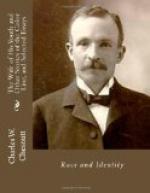“Not for my sake, Clara, no.”
“Well—for mine.” She let him take her in his arms and kiss her again.
“I have a patient yet to see to-night,” he said as he went out. “If I am not detained too long, I may come back this way—if I see the lights in the hall still burning. Do not wonder if I ask you again for my answer, for I shall be unhappy until I get it.”
II
A stranger entering the hall with Miss Hohlfelder would have seen, at first glance, only a company of well-dressed people, with nothing to specially distinguish them from ordinary humanity in temperate climates. After the eye had rested for a moment and begun to separate the mass into its component parts, one or two dark faces would have arrested its attention; and with the suggestion thus offered, a closer inspection would have revealed that they were nearly all a little less than white. With most of them this fact would not have been noticed, while they were alone or in company with one another, though if a fair white person had gone among them it would perhaps have been more apparent. From the few who were undistinguishable from pure white, the colors ran down the scale by minute gradations to the two or three brown faces at the other extremity.
It was Miss Hohlfelder’s first colored class. She had been somewhat startled when first asked to take it. No person of color had ever applied to her for lessons; and while a woman of that race had played the piano for her for several months, she had never thought of colored people as possible pupils. So when she was asked if she would take a class of twenty or thirty, she had hesitated, and begged for time to consider the application. She knew that several of the more fashionable dancing-schools tabooed all pupils, singly or in classes, who labored under social disabilities—and this included the people of at least one other race who were vastly farther along in the world than the colored people of the community where Miss Hohlfelder lived. Personally she had no such prejudice, except perhaps a little shrinking at the thought of personal contact with the dark faces of whom Americans always think when “colored people” are spoken of. Again, a class of forty pupils was not to be despised, for she taught for money, which was equally current and desirable, regardless of its color. She had consulted her foster-parents, and after them her lover. Her foster-parents, who were German-born, and had never become thoroughly Americanized, saw no objection. As for her lover, he was indifferent.
“Do as you please,” he said. “It may drive away some other pupils. If it should break up the business entirely, perhaps you might be willing to give me a chance so much the sooner.”
She mentioned the matter to one or two other friends, who expressed conflicting opinions. She decided at length to take the class, and take the consequences.




